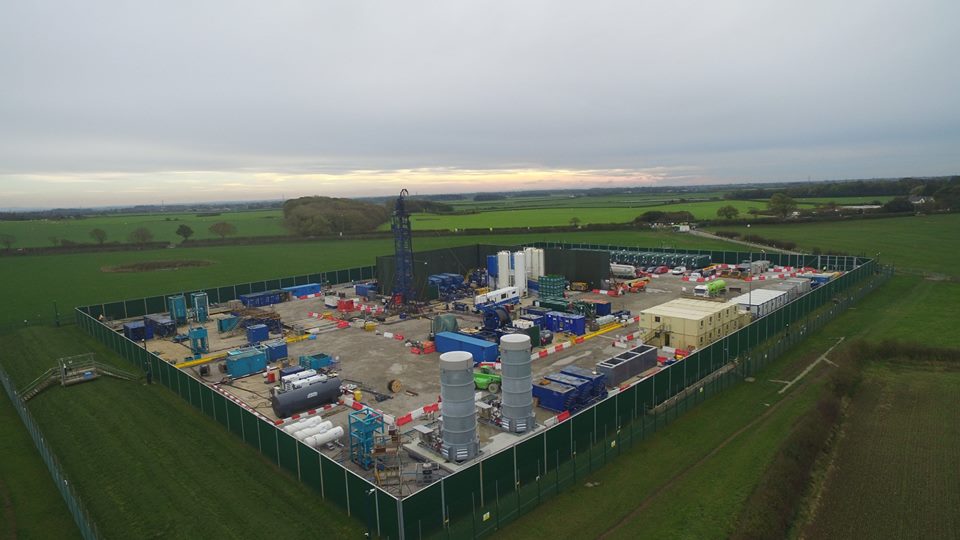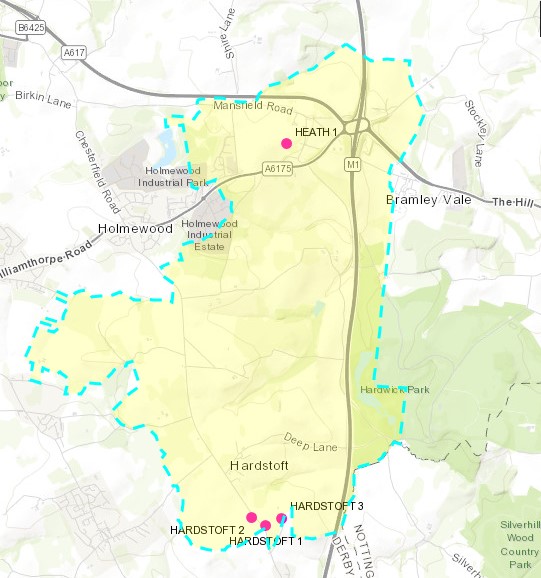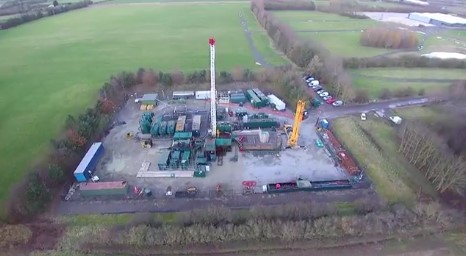
Cuadrilla’s Preston New Road fracking site, 31 October 2018. Photo: Eddie Thornton
Campaigner Ben Dean argues in this guest post that the single word temporary has cleared the way for oil and gas development in rural areas.
Virtually all planning applications for onshore conventional or unconventional hydrocarbon extraction in the UK are either in the open countryside or Green Belt. An exception is Ellesmere Port, where the public inquiry for the refusal of an application by IGas begins tomorrow (15 January 2019).
Cuadrilla’s shale gas site at Preston New Road near Blackpool is in open countryside. Three shale gas exploration sites earmarked by Ineos in north Derbyshire and south Yorkshire are all in the Green Belt. So are the Ince Marshes in Cheshire, chosen by IGas for fracking and the British Geological Survey for its geo-observatory.
So how does the oil and gas industry get planning permission on open countryside and Green Belt land when virtually all other planning applications, except agriculture, would be refused?
The simple answer is onshore hydrocarbon applications are made on the basis that the developments are only temporary.
As the applications are temporary – with the land to be restored post development – the planning officer, planning committee or a planning inspector, can grant permission on the understanding that there is no long-term harm.
I believe this is frankly ridiculous to those residents that may be affected by a hydrocarbon development for the majority, or potentially all, of their lives.

Ineos site at Harthill in south Yorkshire. Photo: Paul Rowland
Is 96 years temporary?
As far as I am aware, there is no precisely-defined length of time for temporary when determining a planning decision. There needs to be.
For me something temporary that has a material effect on the quality of my amenity to enjoy my home – a material consideration to be taken in to account when a planning application is considered – is weeks, perhaps months at most. But the planning system interprets temporary as 30-50 years, sometimes even longer.
The temporary timescale is pushed even further when you consider the exploration licensing system, which operates alongside planning permissions for oil and gas.
Licences are granted by the Oil & Gas Authority (OGA), on behalf of the government, to operating companies, allowing them to explore, appraise and produce hydrocarbons. The timescales of the licences potentially give companies even longer to explore and produce hydrocarbons than the temporary planning permissions.

Licence CE001 covering the Chatsworth area of Derbyshire. Source: UKOGL
The oldest existing onshore licence for hydrocarbon exploration, CE001, was granted to His Grace the Duke of Devonshire, nearly a century ago, on 26 March 1923.
It covers the Chatsworth Estate in the Peak District National Park and has never been used to extract oil or gas.
The grant of this licence was symbolic, but it remains in place, or extant.
Other historic licences that are still extant date back more than 50 years. The oldest, ML003, granted in 1959, runs until 2033, a term of 74 years – not what I would call temporary.
What’s more, the High Court ruled in 2017 that licences are common law contracts, which can be renegotiated and extended if the two parties – the OGA and the operating company – agree. This decision could push the duration of licences to more than 100+ years.
Challenging temporary
In North Yorkshire, Third Energy is challenging the meaning of temporary in the Vale of Pickering.

Third Energy site at Pickering, 1 March 2017. Photo: KMTV
The company has had a licence – PL080 – to explore and produce conventional gas since I1968.
It said last year it was seeking to extend the planning permission for six sites and a gas pipeline until 2035.
The licence is due to expire in 2024 after 56 years. But if the company is successful in extending the planning permission, the licence is also likely to be extended, taking the total duration to 70 years.
I believe this temporary timescale is not acceptable to a local community, subjected to the industrialisation of its open countryside or Green Belt.
There is no parliamentary statutory instrument that limits a licence term to a finite term and present case law states that licences are common law contracts of undeterminable length.
My view is that the planning system should not be looking at onshore hydrocarbon applications as temporary development.
If planners removed the presumption that oil and gas sites were temporary and assumed instead that they were potentially permanent developments in the open countryside or Green Belt, this would move the default position to an automatic refusal, with no prospective grounds for appeal.
DrillOrDrop always welcomes guest posts. If you have an idea, please get in touch here
Categories: guest post

I personally don’t mind if the gas wells are temporary or not because once the wells have been drilled and completed there are very few signs that they are there. If one goes to countries such as the Netherlands, Germany, Austria etc there are onland developments with far higher well densities than well ever have for shale gas yet unless you have knowledge of the industry it is very difficult to tell that you’re above an oil or gas reservoir. I wish the same could be said of wind, solar, biogas etc.
Very few signs that gas wells are there? Like this one in the Netherlands? https://www.theguardian.com/environment/2018/jan/23/gas-field-earthquakes-put-netherlands-biggest-firms-on-extraction-notice
It’s a totally pathetic argument to try and relate Groningen to shale gas. Groningen is a conventional gas reservoir that is very compressible I like shale gas resource plays. In many ways Groningen provides a good example of why u conventionals cause less damage than conventional. You really should do your research before posting on subjects of which you clearly have very little knowledge
Fracking sites like the one at PNR are fairly obvious
And the damage to local property has still not been resolved.
So I agree with you in principle but it doesn’t take special knowledge to judge whether a process is harmful
There has not been any damage to local property as a result of hydraulic fracturing. Where on earth did you get that idea from? You’ve not been listening to Gayzer have you?
So are you saying Gayzer is not being truthful?
I actually don’t think that he’s intentionally lying about the cracks in his house – he’s just added 2 and 2 to come up with the answer 5.
Oh ok you accept he’s not being untruthful, so if it was your house with no cracks
and one day there was an earth tremor
And you found cracks
What conclusion could you draw from that?
People have a propensity to apportion blame on anything they can. This is usually because they have very little understanding about statistics.
It’s just simply impossible that the damage to his house was caused by a 2 ml temor at 6 kms distance.
[Edited by moderator]
[Edited by moderator]
My experience of property repair tells me that (bomb damage aside) cracks don’t suddenly appear in brick built structures by themselves, and subsidence shows itself over time.
I don’t believe that enough is known about the geology of the fylde particular and the behaviour of seismic events in general, by you or anyone else, to flatly rule out a causal link.
On the balance of probability most people would suspect that it was Caudrilla “wot dunnit mud”.
So far, I agree with them.
Well, Chris, your experience appears quite limited!
I could take you to many a NEW housing development where cracks appear within a few months of construction. Every house I have ever lived in has developed cracks. Some of them were relatively new builds some much older. The only people I know who have not experienced this live in timber buildings. If I hire a decorator, then his first job is to go around and fill any cracks as initial preparation.
Size of cracks and nature determine what might be the cause. Cracks, in themselves, are normal. I have one bedroom which is close to the loft access, and will show cracks very quickly along the wall and ceiling joint if the loft hatch is opened repeatedly. I could blame the housing estate under construction a few hundred metres away and try and get that stopped, but people need new houses (all with gas boilers) and I will focus upon the reality of that. I also expect that estate will show large cracks very quickly as the land being built upon is akin to a swamp, but good luck to them!
Lol well bless my soul! My experience is actually irrelevant to this subject, but yes I did mention that I have some.
To recap: cracking in new builds doesn’t happen suddenly, just like subsidence, which it is in a way, it’s the settlement and or contraction of materials in a new build, but either way it takes time. And you don’t need a degree to understand it.
Generally the only cracking that is likely to appear suddenly is either caused by bomb damage, visible in prewar buildings mostly, or earth tremors/earth movement. You don’t need a degree to understand that either.
The USA, land of the free. Or to be precise, a land where the oil and gas industry is largely free to do as it pleases, because they are massive investors in political campaigns and fund a wide variety of psuedo scientific “think tanks” who’s main objective seems to be to fudge the issues and try to confuse the general public.
But that only worked before the consequences were felt by those unfortunate enough to have had their water supplies poisoned, or be lucky enough to now have that fascinating new feature of kitchen cold water taps where you can light flames from them. Or maybe the clusters of birth defects, cancers, I could go on and on, but most people will get the point by now.
In any case the information is all out there, google it, it’s free.
Maybe that’s part of the reason some states are pushing to reduce their reliance on gas and oil by investing in renewable energy sources.
We could learn something from them.
As I thought. Someone who wishes the normal to be the abnormal, claims to have experience and then recommends Giggle!
Sorry, we have been there many times. Giggle is full of rubbish. It will provide what you seek but it is not essentially correct, or provides education. It DOES take knowledge to judge whether a process is harmful. Speculation, fuelled by Giggle, will not produce knowledge.
Oh really! don’t be so elitist.
Anyone can search for information. Everyone does.
Just because they might get info you don’t want them to find that doesn’t make it rubbish.
If the company drilling for oil or gas. or whatever does no harm to people or the environment I’d agree. But that isn’t always the case.
I’m totally intrigued- what form of energy do you know of that doesn’t cause environmental damage?
Thanks Ben; this is a very interesting observation. I would agree that temporary needs to be clarified; interestingly wind turbines are often constrained to 20 years; perhaps that could be a good marker?
And who knows, perhaps people will start building ‘temporary houses’ [lifetime] in greenbelt….that will go down well?
Interesting is a word that should be used sparingly particularly when one is commenting on ones own observations. Failure to do so is similar to Trump telling everyone is that he’s great.
“Temporary” houses would not be mortgageable. Investors take note.
Hi Ben, thanks for your guest post, you are quite right of course, and you illustrate the problem of the ruling that common law contracts enable endless extensions of the licence right here.
“What’s more, the High Court ruled in 2017 that licences are common law contracts, which can be renegotiated and extended if the two parties – the OGA and the operating company – agree. This decision could push the duration of licences to more than 100+ years.”
As you quite rightly say, the term temporary is only a get out clause to fool the planners.
There is a similar problem with the assumption that exploration is not production, and yet the one is necessarily the intention to carry out the other and should be treated as a production licence is treated from the start.
Your conclusion is then perfectly correct, all future planning decisions should assume permanent status right from the start.
Hi Phil C. Happy New Year!
Your point about exploration not being production is a good reminder that the mendacious Francis Egan has been boasting for years now about how soon, usually less than twelve months, residents of the Fylde will be cooking and keeping warm with fracked gas from PNR!
Obviously a pack of lies as only Propane gas from tanks has been flared as yet, according to the environment agency.
And the PEDL only permits testing anyway!
Happy New Year to you too Peter!
Yes, temporary or permanent, exploratory or production, nothing is fixed by the legislation, and hence by that alone. Then on top of that we have the “official” get out of jail free definition of fracking not being fracking if it remains below 10,000 litres production.
And then of course the lack of an engineering definition of proppant squeeze, and the doubts over such proposals as electrocoagulation, yes, i spelled that correctly having effects on water and surrounding geological strata stability and integrity.
And then the severe doubts over the use of Hydrofluoric acid, the most poisonous acid on the planet, HF from hydrogen fluoride in water which produces highly toxic gas that damages respiratory systems, the use of which was denied right here, only to be revealed as a possible use by the operators themselves.
And then again the effects of all this wishy washy lack of certainty upon the water supply and the target and other geological strata stability and integrity.
And then we get the issue of old style licences and their lack of requirement to record or report anything they have done prior to July last year and then no requirement for those 38 sites to report anything at all or comply with the new style licences for another 10 months.
Ben Dean is absolutely correct, any potential extraction operations should only be termed permanent production right from the beginning and then maybe we will begin to see some movement in planning restrictions on operators.
Please tell me if i have missed anything Peter?
[Comment corrected at poster’s request]
And the value is likely to go down instead of up. You investors listening?
Wind farms are (or were) also deemed temporary to avoid greenbelt / AONB / landscape issues. However the 20 years comes from the planning applications by the developers who was not interested in having planning permission any longer than the designated period of free money – ROCs / FITS – usually 20 years.
For Sherwulfe – not sure why it ended up down here?
Perhaps the temporary would be more temporary if the whole process was speeded up? As there is a finite amount of gas/oil that a site will be able to extract, then speed up the initial stages especially (where the disruption mainly occurs) get to the extraction quickly, and then many-even locals- will forget the sites are there-just like KM, and the wildlife can flourish-just like Wytch Farm.
Of course, there is also the situation where companies sit on sites without progressing them for many years, often related to what is happening to oil and gas prices. Quite standard within many industries and should not be confused with the semantics of temporary.
Morning Martin,
The title of this publication relates to the quite sensible time limits applied to oil and gas exploration licences.
Apparently the failure to have similar limits on housing development permissions has caused massive land banks to be created which don’t count towards target housing numbers and enabling ridiculous amounts of additional planning applications to be approved.
Morning Peter,
Your quite sensible is a bit like temporary-simply an opinion which will differ according to the perspective you hold.
Land banks, for example, can be there for many reasons. Maybe the infrastructure locally has not been established to make the development of a particular site attractive to potential purchasers, and that is largely due to the way different departments tend to work in isolation. Some parallels there for the oil and gas industry, which is often why extensions to licences are required.
Thank you for a clear article
Maybe people should look at the USA example before they push too hard for time restrictions on fracking activities. In the USA companies have 3 to 6 years to drill a license. As mineral rights are owned by the landowner there are a massive number of licenses in each area. This has meant that the industry has had to drill a huge number of wells very rapidly. This has resulted in the market being flooded by gas, which has dramatically reduced the cost. This has undoubtedly helped the USA switch from coal to gas. However, low gas prices also tend to result in increased consumption. The huge number of wells drilled has also meant that the industry in the USA isn’t so well regulated.
Meanwhile, INEOS investing 3 billion Euro in Antwerp. Shame for Nicola, but what did she expect. Hope Bridgend doesn’t suffer the same.
A very important point raised here by Ben.
Regardless of what shouty shouty Judith Green says, people just do not want these sites parked outside their houses for the rest of their lives.
The thought of thousands of these things left poorly regulated, because the government can’t afford to prop up the Environment Agency to that extent, is not a pleasant thought at all.